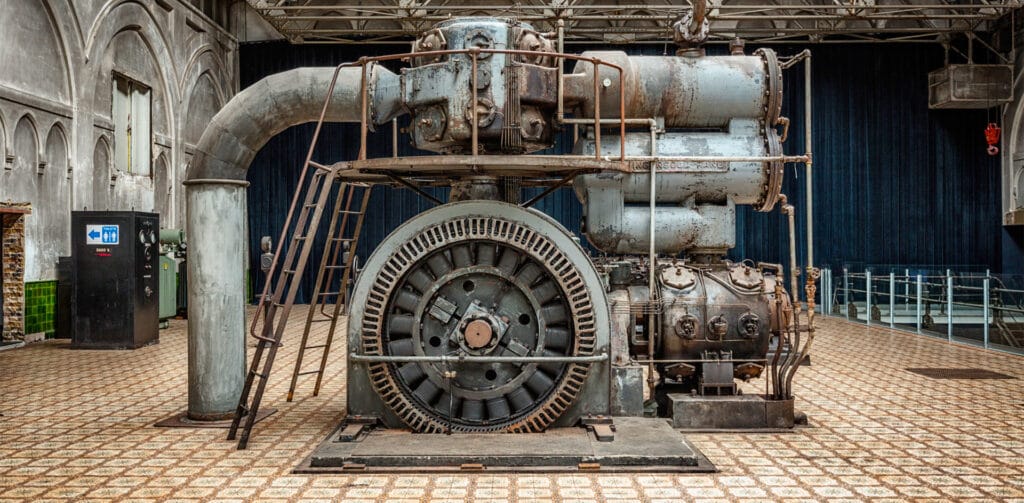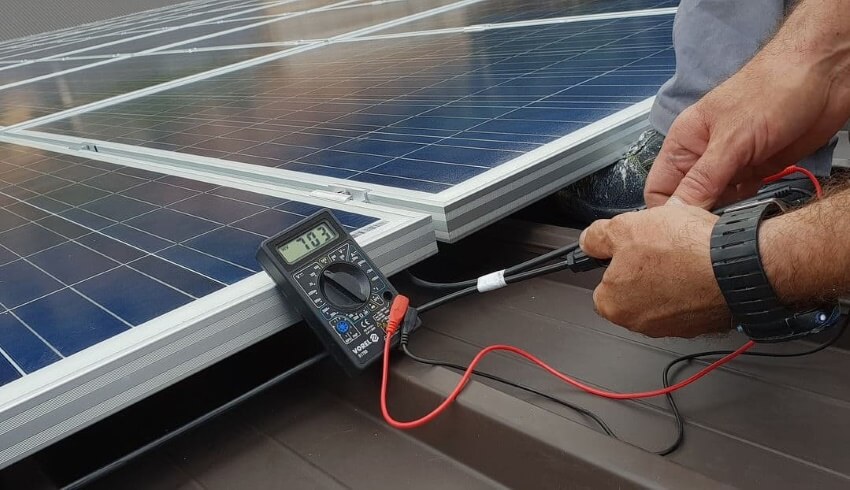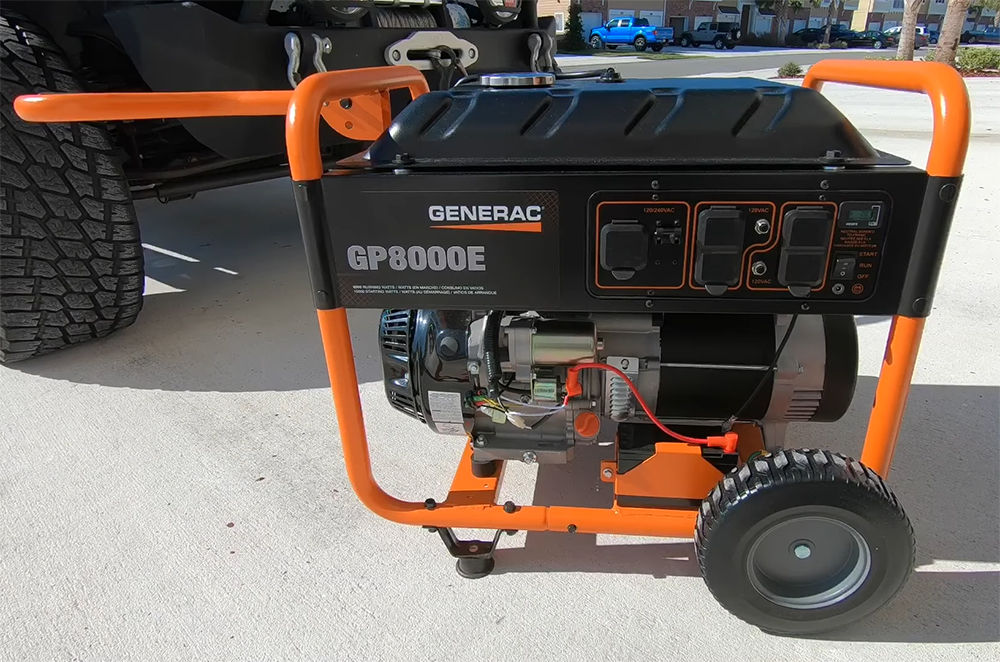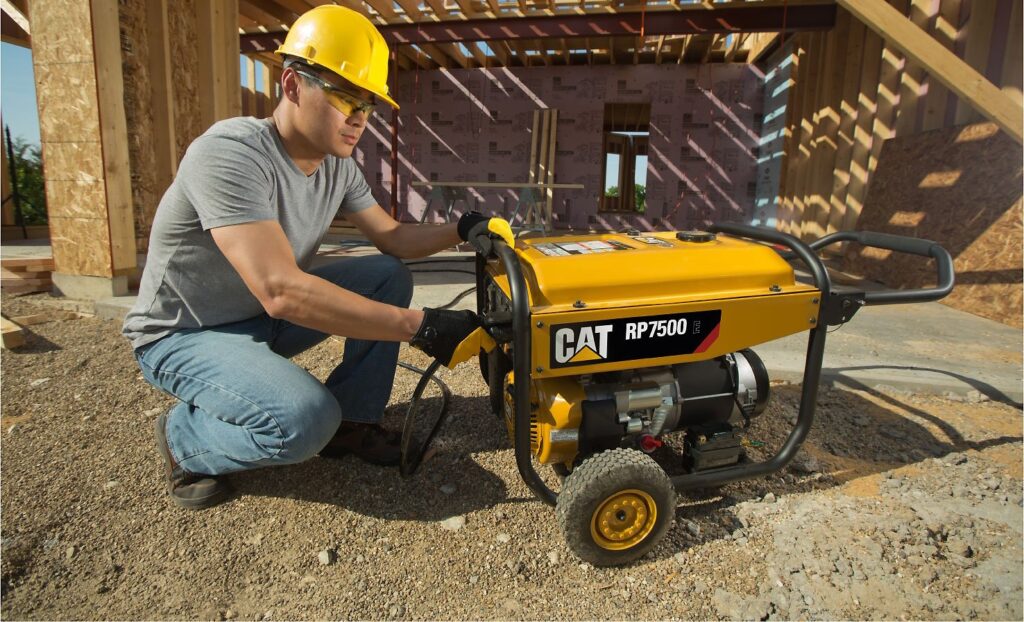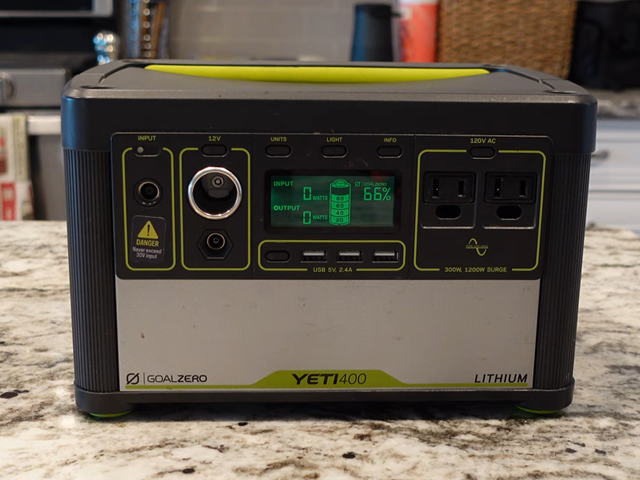
Both gasoline and propane have their advantages and disadvantages for powering a portable generator. With a dual-fuel generator, you can get the benefits and flexibility of using either fuel source for your power.
We took a close look at 24 of the most well-reviewed dual-fuel generators on the market in order to help you find the best options. It was hard to choose, but we think the Champion Power Equipment 76533 is the overall best dual-fuel generator on the market. It offers a huge amount of power and a pair of 30-amp outlets for powering any tools or RVs, plus it’s loaded with ease of use features like an electric start. There are plenty of other dual-fuel generators worth your consideration, though, and we rounded up nine more of our favorites to review.
When choosing the best dual-fuel generators, we first looked at the peak and rated power on both gasoline and propane. This is hugely important since it determines a lot about what you’ll be able to power with your generator. We also looked at runtimes and fuel efficiency, as well as the types of outlets available for your electronics and appliances. Finally, we considered the engine and ease of use features that ensure you’ll have a great dual-fuel generator experience. We spent tens of hours poring over customer reviews and technical specifications to make our final selection. You’ll find all 10 of what we consider the best dual-fuel generators highlighted in the table below, followed by detailed reviews and a buying guide that can help you determine which generator is right for you.
This powerful and versatile dual-fuel generator from Champion Power Equipment took home our Editor’s Choice award. The generator is capable of producing up to 4,750 surge or 3,800 running watts on gasoline. When running on propane, there’s a significant power drop, but you still get over 4,200 surge and 3,400 running watts. The generator is powered by a highly efficient 224cc four-stroke Champion engine, so you don’t have to worry that it’s not using fuel to maximum efficiency. It also comes equipped with all the necessary safety features, including low oil shut-off, so you don’t have to worry.
This portable generator’s load time is good, but not great. The gasoline fuel tank is only 3.4 gallons, which limits you to a runtime of nine hours at a 50% power draw. On propane, you get 10.5 hours – better, but you’ll still have to refuel partway through the day if you need the generator’s full power output.
What users loved most about this generator is how easy it is to run. It comes equipped with an electric start function. An LED hour meter helps you keep track of how much power you’re using and how much fuel you have left. RV owners loved that one of the 30-amp twist-lock outlets is RV-ready without the need for an adapter. A second 30-amp outlet is ideal for heavy-duty applications, while a 12-volt DC outlet allows you to easily charge batteries. The only extra thing that would have been good was a second 120-volt duplex. The outlets are on their own circuit breakers, which makes resetting after a surge very simple.
Unfortunately, this portable generator isn’t all that quiet, producing 68 dB of noise at a 25% output. That’s not too loud for RV use, though, and it’s about what you’d expect from a generator this size. Just beware that it can get quite loud when running near full power.
Users rave about this dual-fuel generator from Pulsar, which offers a ton of features to improve its usability. To start, there’s hardly a difference between the power outputs when running this generator on gasoline or propane. In both cases, you get around 7,500 watts of surge power and around 6,000 watts of running power. That’s thanks to the massive 420cc four-stroke OHV engine, which users describe as being extremely reliable over years of use.
It’s worth noting that Pulsar built this portable generator with a truly massive fuel tank. The 6.5-gallon tank allows you to run this generator on gasoline for up to 13 hours at a 50% load, which gets you pretty close to a full day of work even if you draw all the available power. On the other hand, this generator continuously runs on propane for around 8 hours if you use a standard propane tank. Users also loved that you can switch seamlessly between propane and gasoline (without losing much power), so you can move onto propane if you don’t want to wait for the generator to cool down or interrupt your power supply.
The outlet panel on this generator is also impressive. There’s a digital hour meter and an electric start function. On top of that, the generator is equipped with a pair of 120-volt duplexes and two twist-lock outlets, one of which is able to output 240-volt power. So, there’s very little worry about running out of outlets when using this generator.
The only thing that users didn’t love about this dual-fuel generator is that it’s very loud. The generator makes 75 dB of noise at a 25% load – that’s loud enough that you’ll want to consider ear protection if you’ll be working close to the generator for a while, or if you’ll be using all of its running wattage.
This burly dual-fuel generator from Champion Power Equipment is an ideal choice for powering a work site or a large home during a blackout. This portable generator offers a massive 10,000-watt surge power when running on gasoline, as well as 8,000 running watts. The power drop to propane is somewhat large, considering you only get 9,025 watts of surge power and 7,250 watts of running power.
The generator’s fuel tank is just large enough to give you a full day of work, that is, around 8 hours, if you’re running at a 50% load on gasoline. However, you’ll need a 35-pound propane canister or larger to get a full day at a similar power draw if running on propane.
One of the things that users liked about this generator is that the 120-volt duplexes – there are two of them – are backed by GFCI circuits for safety, which makes it one of the best dual-fuel generators for worksites. There are two 30-amp outlets, and one of them provides 240-volt power so you can run heavy-duty shop tools without ramping up the current too much. Users also liked the digital hour meter that Champion included on this generator, although it would have been nice to have a 12-volt DC outlet for charging power tool batteries and the onboard battery for the electric starter. Still, these were small complaints about an otherwise stellar construction.
When it comes to noise, users were less thrilled – that’s one of the reasons this dual-fuel generator is better for worksite use than home use. The generator produces 74 dB of noise at a 25% load, and can easily top 80 dB when running at full power. It’s large size also makes it relatively difficult to move, despite the fact that it’s mounted on never-flat wheels.
This compact and capable dual-fuel generator from Firman is a great choice for camping and other outdoor activities. While it weighs in at over 130 pounds, users are quick to point out that the manufacturer went to great lengths to make it more portable. The folding U-shaped handle is easy for one person to grab, or even two if you want to split the weight. The eight-inch, heavy-duty never-flat wheels are able to travel easily over rough and rocky terrain, so you’re not just limited to the yard or a parking lot. On the top of the generator, the grab bar extends all the way around the frame so any number of people can help lift the unit.
This dual-fuel generator offers just the right amount of power for camping, RVing, and tailgating, too. You get over 4,000 watts of surge power when running on either gasoline or propane, and 3,650 watts of running power on gasoline. The five-gallon fuel tank ensures that you get a whopping 14-hour runtime at a 50% load, so you hardly have to worry about refueling.
RV users will be happy to know that this generator includes an RV-ready 30-amp twist-lock outlet. It also has a second twist-lock outlet and a 120-volt duplex. But, beware that there’s no 12-volt DC outlet for charging a dead car battery, and no electric start to make getting the generator fired up easier.
One of the things users appreciated most about this generator is that, while it’s far from quiet, it’s not overly loud either. The generator produces 63 dB of noise when you turn it on, but it only ramps up to 68 dB of noise when you draw the full available power. That’s good for camping and RVing, since you’re less likely to bother anyone that’s camped nearby.
This massive dual-fuel generator from Westinghouse is designed for anyone who needs as much power as possible from their generator. This beast is built around a 13.5-horespower, 457cc, four-stroke Westinghouse engine. That provides a whopping 12,500 surge and 9,500 running watts on gasoline, or 11,200 watts of surge power and 8.500 watts of running power on propane. In this power range, the difference between the running and surge power is actually helpful for starting up very large motor-driven appliances and power tools.
As you’d probably expect, this dual-fuel generator is extremely loud and not the most fuel-efficient. It produces 74 dB of noise at a 25% load and can be well over 80 dB when running close to full power. So, you’ll want to be careful running this generator outside of daytime hours and you’ll likely want to wear ear protection when operating it. Westinghouse equipped its portable generator with a surprisingly small 6.6-gallon fuel tank, so it only gets 17.5 hours of runtime at a 25% load. You’ll want to invest in a large propane tank if running this generator on propane.
What really sets this dual-fuel generator apart from the pack is that it’s capable of delivering power at a current of 50 amps as opposed to just 30 amps. It has two twist-lock outlets that can switch between 120-volt and 240-volt electricity, which makes it ideal for heavy-duty applications. Users also appreciated that Westinghouse built it with four 120-volt outlets, so you don’t have to worry about running out of outlets to plug everything in.
The generator also takes electric start to the next level by giving you a key fob that lets you start the generator remotely. That’s a big plus if you’re using it to power your home during an outage and don’t want to go outside.
Just beware that while this dual-fuel generator is designed to be portable, it’s hard to move. It weighs 220 pounds.
Warranty: 2-year limited on parts, 1-year limited on labor
Ford is best known for its trucks, but it brought the same incredible standard of engineering to this dual-fuel generator. The generator is built around a custom 420cc four-stoke OHV Ford engine, which provides 7,500 watts of surge power on propane and 7,750 watts on gasoline. The running power is also quite impressive – 6,000 watts on propane and 6,250 on gasoline. Helpfully, this generator is also built so that you can switch seamlessly between the fuel sources without dropping your power or turning off the generator.
A large 6.6-gallon fuel tank ensures that you get plenty of runtime from this generator. It offers 10.5 hours at a 50% load on gasoline. While Ford doesn’t specify the generator’s runtime on propane, users noted that a 20-pound canister will get you an entire day’s worth of power if you use a 50% load or less.
The outlet panel on this generator is quite nice, if somewhat similar to what competitors offer. This portable generator has four 120-volt outlets and two 30-amp twist-lock outlets. One of these is capable of toggling between 120-volt and 240-volt power, so the generator is more than able to deal with heavy-duty appliances. It seems like Ford forgot a 12-volt DC outlet, though, which is problematic since it makes it hard to charge the battery for the on-board electric start. The digital hour meter is a nice touch so that you can keep an eye on your power draw and remaining runtime.
Users thought that this generator was loud, but not excessively so given its large size. The noise production tops out at 76 dB when the generator is running at full power, which is significantly quieter than some similar conventional generators.
This moderately sized dual-fuel generator from DuroMax is unique in that there’s no power drop when switching between gasoline and propane. That’s not hugely important, but it is nice to know that you won’t be forced into one fuel over the other based on how much power you need to draw. This portable generator is capable of producing up to 5,000 watts of surge power or holding 4,000 running watts.
This conventional generator is unfortunately not the most fuel-efficient offering on the market. The four-gallon tank offers a runtime of less than 9 hours on gasoline and less than 8 hours on propane at a 50% load. The 7.5-horsepower engine is more than powerful enough to cover the wattage demand, but it’s perhaps a little too beefy for the overall design of this generator.
Unfortunately, such a large motor also means a lot of noise. This dual-fuel generator produces 69 dB at a 25% load, and it only gets louder as you draw more power. Users noted that you might need to restrict your use of this generator during the evening hours if you have neighbors close by.
That said, we liked that the generator is equipped with a wattage indicator – even if it’s analog rather than digital – as well as an electric starter. The 120-volt duplex outlet is backed by a GFCI circuit for safety. Even better, the 30-amp outlet can be toggled between 120-volt and 240-volt power, so you can use this portable generator for heavy-duty appliances and power tools around the house.
For the amount of power you get, the price of this dual-fuel generator is extremely attractive. DuroMax also includes a three-year warranty, so you don’t have to worry about problems with longevity.
This conventional dual-fuel generator from Wen is a great choice for anyone who needs power on a tight budget. The generator is priced to move, while still supplying 4,750 watts of surge power on gasoline and 4,350 watts on propane. The rated power output is a little disappointing – you only get 3,800 running watts on gasoline and 3,500 on propane, so there’s a pretty significant power drop.
Users loved that Wen built this generator with a pretty large four-gallon fuel tank, so it can run for 11 hours at a 50% load. The runtime on propane doesn’t stack up quite as nicely – just seven hours for less power – so you’ll probably want to invest in a larger propane tank than the standard 20-pound canister.
The outlet panel on this dual-fuel generator is relatively simple. The 120-volt duplex is backed by a GFCI circuit, and there’s a 30-amp twist-lock outlet that can be converted between 120-volt and 240-volt power. But, there’s not much else. This generator doesn’t have a wattage meter, and it would be difficult to use with an RV without an adapter for the twist-lock outlet.
The generator does come with an electric start, which users appreciated given the low price of this model. It’s also worth noting that the ignition on this generator requires a key. Depending on your perspective, that offers increased security or detracts from the generator’s ease of use.
The DF475T is relatively loud, especially since its output wattage is modest at best. The generator starts off at about the same volume as the DuroMax portable generator, which provides significantly more power and has a much larger engine.
Wen provides a two-year warranty on this dual-fuel generator, which is pretty good considering the price.
If you’re in the market for a dual-fuel inverter generator, look no further than this 3,000-watt generator from Champion Power Equipment. The second best dual-fuel generator on our list, this compact and highly portable model is capable of producing over 3,000 watts of surge power on either gasoline or propane, and impressive 3,100 running watts on gasoline. The four-stroke inverter engine is incredibly fuel-efficient, allowing you to run at a 25% power load for nearly a full day on just a 1.6-gallon fuel tank.
What’s great about this generator is that it’s highly portable without giving up on utility. The generator features an RV-ready 30-amp outlet so you can easily take it on road trips. The 120-volt duplex is plenty for a generator this size. We’d love to see a USB outlet to take advantage of the inverted power for small electronics, but that’s a relatively minor complaint – especially since it does have a 12-volt DC outlet you can use.
Even more impressive is the size and portability of this dual-fuel generator. It weighs in at just under 100 pounds and has a pair of never-flat wheels on the bottom of the frame. While the wheels are too close to the ground for off-road travel, they make it extremely easy to carry the generator around your home, a campsite, or over a paved road. A pair of handles allow two people to lift the generator without much trouble.
While there’s no hour meter on this dual-fuel generator, it does have an electric starter for ease of use. On top of that, it’s fairly quiet, producing just 59 dB at a 25% power load. That’s about 10 times as loud as some of the gasoline-only inverter generators of this size, but it’s a small price to pay for the ability to switch between fuels. It is also a very safe system to use, as it has a low oil shut off sensor and is EPA certified. Users also loved the three-year warranty, which offers peace of mind when purchasing this dual-fuel generator.
This inexpensive dual-fuel generator from Sportsman is beloved by homeowners and RVers on a tight budget. The generator offers the right amount of power – about 4,000 watts of surge power and 3,000 to 3,500 watts of running power – for a wide variety of applications. While the generator only comes with a short one-year warranty, users stand behind the company’s seven-horsepower, four-stroke OHV engine.
The generator offers a solid runtime on either gasoline or propane. Sportsman built in a 3.6-gallon fuel tank, which allows you to run the generator for up to 10 hours on gasoline at a 50% load. When running on propane, a standard 20-pound canister can give you 50% power for up to 12 hours.
They like that the generator is extremely simple, leaving behind only the essentials that are required in a solid dual-fuel generator. It has an analog wattage meter so you can monitor your power draw. There’s a pair of 120-volt outlets and a 30-amp, RV-ready twist-lock outlet. This generator isn’t capable of producing 240-volt power, but that’s not particularly a disadvantage for the target users of this model. The only “extra” that would have been nice is an electric start, but customers found that the recoil starter works readily on the first pull or two every time.
This dual-fuel generator is somewhat loud for its size, but that’s not too surprising given its budget price. The generator produces 69 dB of noise at a 25% load, and gets up to around 74 dB at full power. Note that while this generator is compact and reasonably light – it weighs just 90 pounds – there are no wheels on it. That means you’ll probably need two people to lift it in and out of an RV or to move it around your campsite.
Now that you’ve learned more about the best dual-fuel generators we could find, how do you decide which one suits your power needs? In our buying guide, we’ll cover everything you need to know about why dual-fuel generators are great and how to choose the one that is right for you.
Gasoline and propane are two of the most common fuel types used by generators, and both have advantages and disadvantages. For example, gasoline is very power-dense, enabling high output wattages, but it’s also expensive and doesn’t store very well. Propane, on the other hand, is cheaper, often easier to carry around in large volumes, and lasts for years without going stale. But, you typically get less wattage for your fuel with propane. However, if you get one of the best dual-fuel generators, the difference won’t be that great.
A dual-fuel generator gives you the flexibility to use whichever fuel best suits your situation. Say you want to use your generator both for tailgates and for dealing with blackouts at home. You can use gasoline to get more power at your tailgate, while keeping propane – which stores for years – at home for use during a power outage. This kind of flexibility makes it much easier to use a single generator in every situation, rather than compromising and using a fuel that doesn’t make much sense for certain applications.
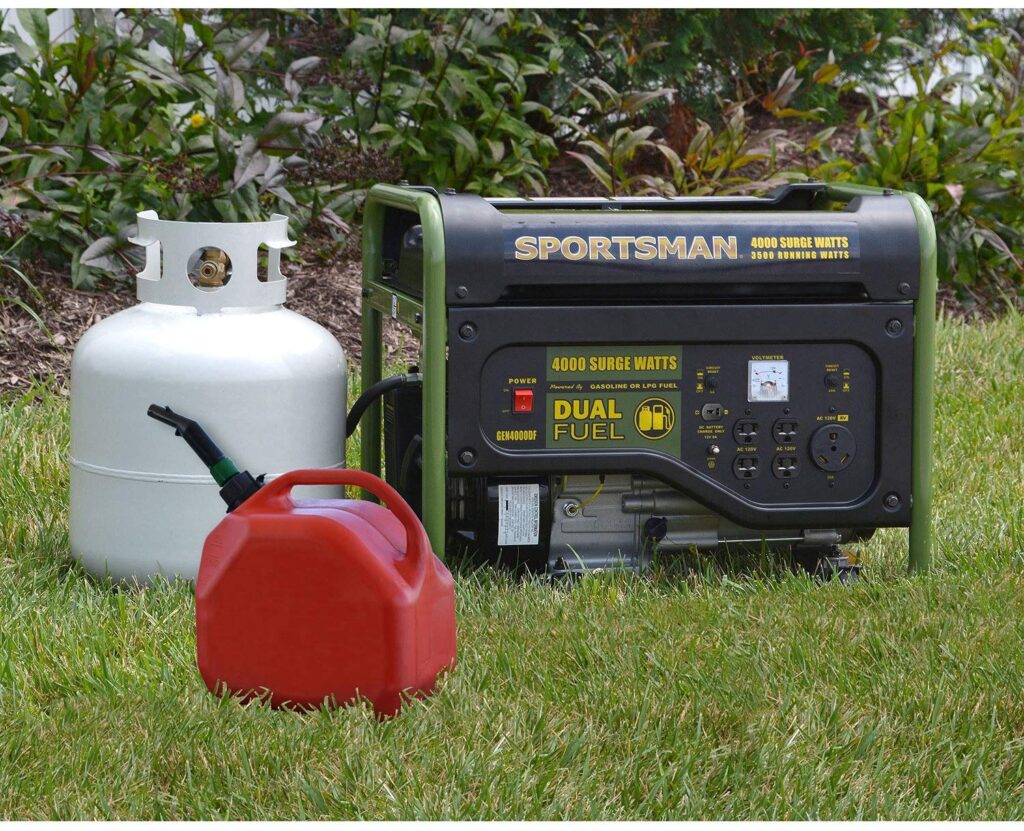 Features to consider before you buy a dual-fuel generator
Features to consider before you buy a dual-fuel generatorIf you’re convinced that a dual-fuel generator can help with your power needs, the next step is to figure out what features you need. Let’s take a look at some of the most important things you need to know about when choosing one of the best dual-fuel generators.
A generator’s power output is measured by two numbers: surge wattage and continuous wattage. The surge wattage is the amount of power the generator can put out for a short time, on the order of several seconds. This peak wattage allows you to overcome the high power requirements of starting up motor-driven appliances like refrigerators, freezers, and power tools.
The continuous wattage is the amount of power that your generator can keep up as long as it has fuel. The sum of the wattage requirements of everything you plan to power should be less than the continuous wattage rating.
Keep in mind that dual-fuel generators will actually have four power ratings, since the surge and continuous wattages depend on whether you’re using gasoline or propane as your fuel. Gasoline is more energy-dense, so generators will typically be able to produce more power when you’re running on gasoline. Just make sure that the wattage drop when switching to propane isn’t too extreme (more than a few hundred watts), or you lose a lot of the benefits of having a dual-fuel generator in the first place.
Dual-fuel generators span a huge range of power outputs. For example, the Westinghouse WGen9500DF is a beast of a generator capable of producing 9,500 watts of continuous power on gasoline. Meanwhile, the much smaller Champion Power Equipment 100263 produces just 3,100 running watts on gasoline.
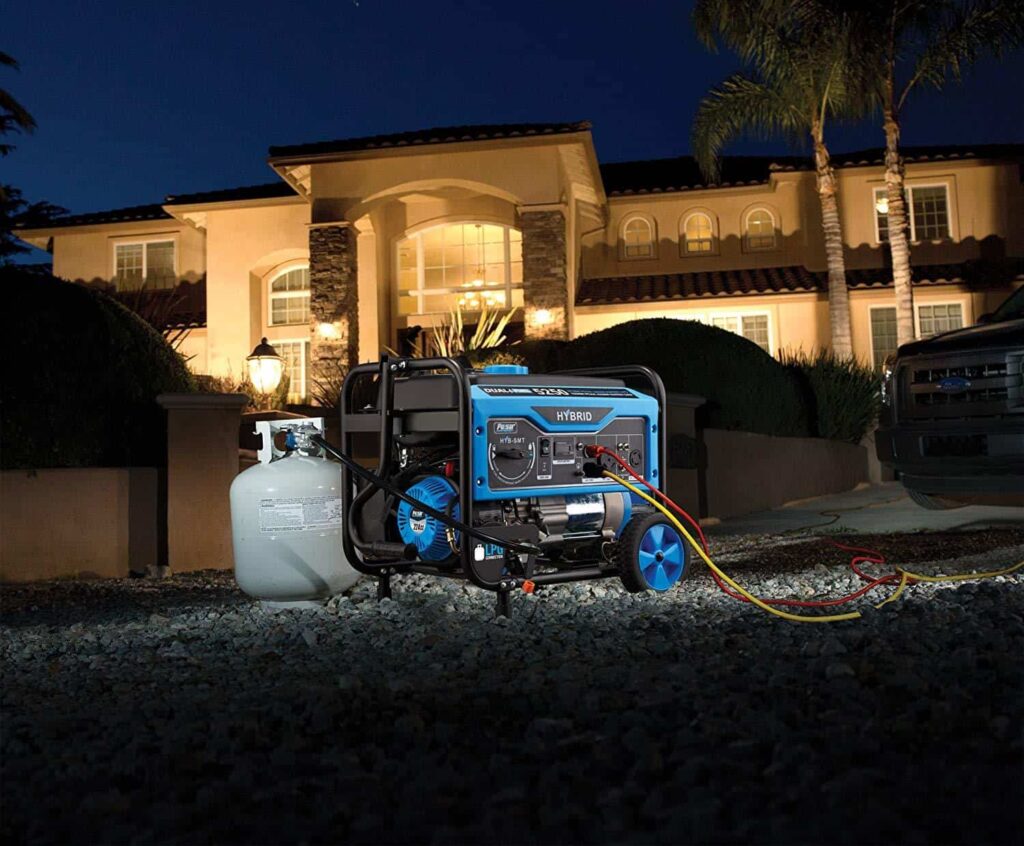 Runtime and efficiency on gas and propane
Runtime and efficiency on gas and propaneYour dual-fuel generator’s runtime describes how long it can run on a single tank of gasoline or a standard 20-pound canister of propane. Runtime is generally more important when running on gasoline, since you can’t make the fuel tank any bigger – once you run out of fuel, you need to wait 20 minutes for the generator to cool off before refueling. When you’re running on propane, it’s possible to simply use a larger propane canister or to hook two propane canisters up via a switch valve so that you can change seamlessly from one canister to the next.
It’s also important to think about fuel efficiency – after all, no one wants to pay more for fuel.
Higher wattage dual-fuel generators will almost always use more fuel and they tend to be less efficient at low wattages than smaller generators. However, running two generators is much less efficient than running one. So, make sure you have enough power to cover your needs before you compromise on fuel efficiency.
The outlets that your dual-fuel generator is equipped with matter a lot for powering your devices. You’ll want to think about whether you need 240-volt power, which is available on larger dual-fuel generators like the Champion Power Equipment 100297, Ford, and Westinghouse generators. If you have an RV, you’ll want to look for a 30-amp twist-lock outlet – and ideally one that’s RV ready, like on our Editor’s Choice Champion Power Equipment 76533. More outlets is generally a good thing, since it gives you more flexibility to power a variety of different devices.
Every dual-fuel generator comes with a recoil starter, which is the infamous pull cord that requires some work to get the generator started. But, many dual-fuel generators are also equipped with an electric starter – all you have to do is push a button or turn a switch to turn on the generator.
This is an incredibly helpful feature that’s available on all of the Champion Power Equipment dual-fuel generators, as well as the Ford, Westinghouse, and Pulsar models.
Having the recoil starter as well is important, since this serves as a backup in case the battery ever runs out of juice.
All of the dual-fuel generators we reviewed come with basic safety features like a low oil shut-off, as well as overload shutoff, and a fuel gauge for easy monitoring. These features protect the generator’s engine and your appliances from damage, as well as prevent a dangerous electrical surge. You may also want to look for outlets that are protected with a GFCI circuit to prevent surges, which are available on the Wen, DuroMax, Ford, and Champion Power Equipment 100297 dual-fuel generators.
Noise is an unfortunate part of running a generator. But not all dual-fuel generators are equally noisy. Power matters a lot – larger generators will typically be louder, and a given generator is likely to increase in volume as you draw more wattage from it.
When considering a dual-fuel generators based on its noise output, keep in mind that the quietest portable generators on the market still produce around 50 dB of noise and that noise levels are typically measured at a 25% power output.
A dual-fuel generator is a big purchase, so you want to be sure it will last for many years to come. Most manufacturers offer at least a one-year warranty to protect against defects, and many go much further than this. Champion Power Equipment, Westinghouse, Firman, and DuroMax all offer three-year warranties on their dual-fuel generators to provide you with unparalleled peace of mind.
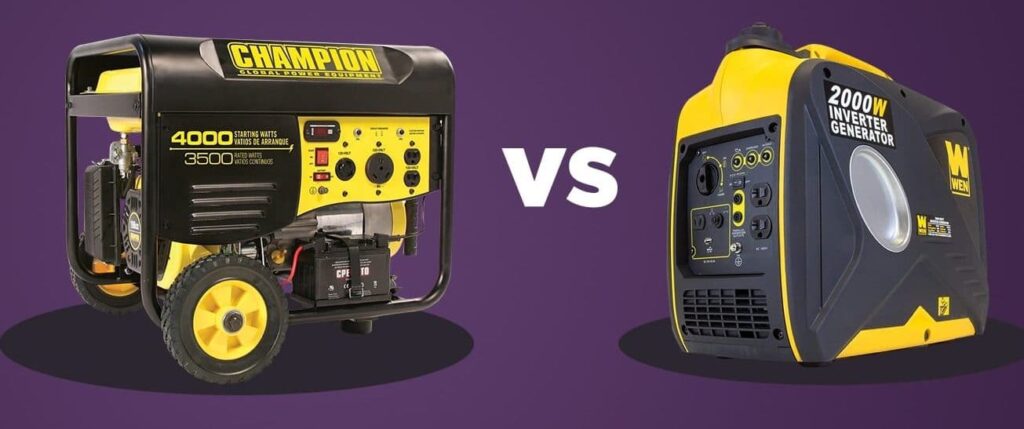
The downside to inverter generators is that they’re limited in power – inverter dual-fuel generators rarely produce more than 4,000 watts of power. In addition, inverter generators tend to be much more expensive than their conventional counterparts.
Our three picks for the best dual-fuel generators on the market today are the Champion Power Equipment 76533 and 100297 generators and the Pulsar PG7750B. The Pulsar dual-fuel generator is a crowd favorite, offering a huge variety of outlets and solid runtimes on gasoline and propane. Even better, this generator has very little power drop when switching from gasoline to propane, so you don’t have to compromise when choosing a fuel. The Champion Power Equipment 100297 is our favorite dual-fuel generator for worksites. This portable generator offers a massive 10,000-watt surge power and runs up to 8 hrs at half load. We feel the Champion Power Equipment 76533 is the overall best dual-fuel generator thanks to its impressive power output and huge range of features. The generator offers a pair of 30-amp outlets, one of which is RV-ready, and offers plenty of runtime no matter which fuel you choose. Plus, it’s hard to beat Champion’s three-year warranty for ensuring your generator will last for years to come.
